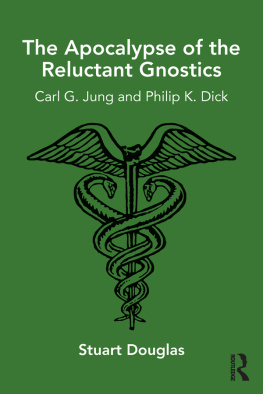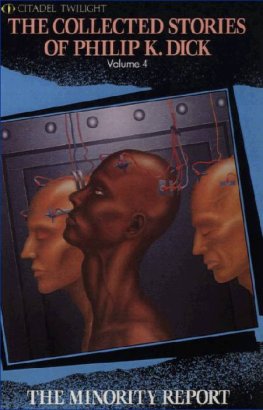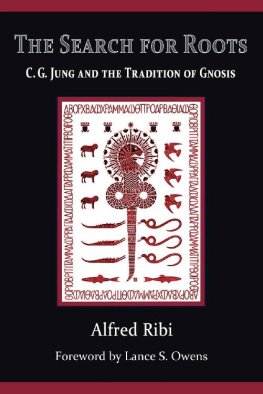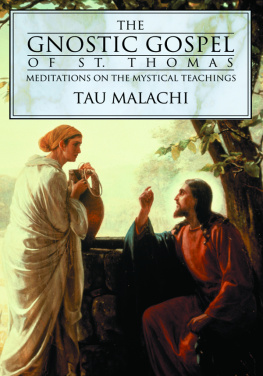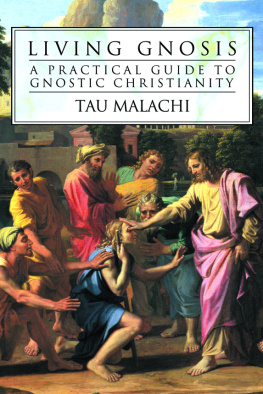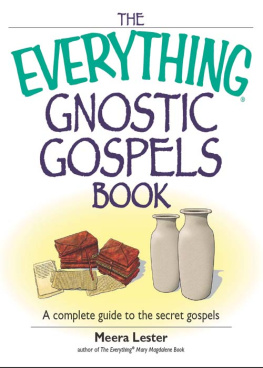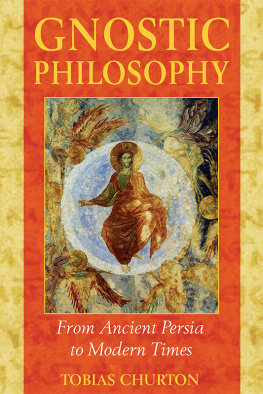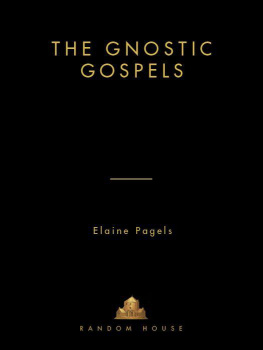THE APOCALYPSE OF
THE RELUCTANT GNOSTICS
THE APOCALYPSE OF
THE RELUCTANT GNOSTICS
Carl G. Jung and Philip K. Dick
Stuart Douglas

First published 2018
by Routledge
2 Park Square, Milton Park, Abingdon, Oxon OX14 4RN
and by Routledge
711 Third Avenue, New York, NY 10017
Routledge is an imprint of the Taylor & Francis Group, an informa business
2018 Stuart Douglas
The right of Stuart Douglas to be identified as author of this work has been asserted by him in accordance with sections 77 and 78 of the Copyright, Designs and Patents Act 1988.
All rights reserved. No part of this book may be reprinted or reproduced or utilised in any form or by any electronic, mechanical, or other means, now known or hereafter invented, including photocopying and recording, or in any information storage or retrieval system, without permission in writing from the publishers.
Trademark notice: Product or corporate names may be trademarks or registered trademarks, and are used only for identification and explanation without intent to infringe.
British Library Cataloguing-in-Publication Data
A catalogue record for this book is available from the British Library
Library of Congress Cataloging-in-Publication Data
A catalog record has been requested for this book
ISBN: 978-1-78220-607-1 (pbk)
Typeset in Palatino LT Std
by Medlar Publishing Solutions Pvt Ltd, India
apocalypse
noun
any of a class of Jewish or Christian writings that were assumed to make revelations of the ultimate divine purpose.
a prophetic revelation esp. concerning a cataclysm in which the forces of good triumph over the forces of evil.
any revelation or prophecy.
any universal or widespread destruction or disaster.
origin
from Greek apoklypsis, from apokalptein revelation, to uncover, to reveal (apo- + kalptein to cover, conceal) + -sis.
CONTENTS
CHAPTER ONE
Introduction
CHAPTER TWO
The living and the dead
CHAPTER THREE
Ex nihilo, ex plenitudo
CHAPTER FOUR
The darkness and the light
CHAPTER FIVE
Archons and archetypes
CHAPTER SIX
The cave and the prison
CHAPTER SEVEN
The dream and the hologram
CHAPTER EIGHT
The seed and the sheaf
CHAPTER NINE
The self and the homoplasmate
CHAPTER TEN
The virgin and the whore
CHAPTER ELEVEN
Slavery and freedom
CHAPTER TWELVE
Christ and Sophia
CHAPTER THIRTEEN
The imagination and the third eye
CHAPTER FOURTEEN
Reluctant gnosis
I go into an old church in the town I grew up in. Im looking for a mission card (i.e., a card with my mission written on it) for the next phase of my life. I expect to find it on a window sill on the left-hand side. I find it where I was expecting, however I am a little surprised, and think: This is real! The mission card is about the size of a playing card, but the print is very small. I scan down the card and the only words that I can manage to read are, Carl Jung. I ask a young woman if she can read what is on the card. She is about to do this when, distracted by an external noise, I wake up
(Authors dream journal, July 2015)
In the closing remarks of my first book, white Bird, Black serpent, Red Book, I noted that Jung had admitted that he felt that he had failed in what he considered to be his principal task: to awaken people to the fact that they have a soul, which he likened to a treasure buried in a field. I suggested that there was no failure on Jungs part, rather, the failure was on the part of others for not having fully realised what his lifes work was really all about. I concluded that it now fell to others, particularly those who resonate with the Gnostic worldview on which his psychology is founded, to continue Jungs unfinished project. At that time, I did not feel that I would be among them. I thought my exploration of Jungs work, and in particular, its Gnostic heritage, was complete, and I could move on to other things. Little did I realise, I would feel called to participate in the continuation of his unfinished project. This dream certainly suggests as much, and the present work is the result.
In Jungs psychology, the completion of psychological development and the attainment of psychological wholeness requires the reconciliation and integration of all opposites within the psyche. In my first book, I had commented that there was nothing more crucial to the salvation of humanity in our time than the restoration of the long-suppressed feminine principle. Only once the feminine has been restored as co-equal with the male principle can the integration of the male-female polarity occur. According to Jung, the equality of the feminine principle necessitates not simply the equality of women, but an actual equivalence of the feminine principle in its entirety, not only psychologically and spiritually, but also in a way that anchors the feminine in the figure of a divine woman in the same way that the divine masculine is represented in the figure of Christ (for Christians). He dismissed the notion of the Church as a symbol of the feminine as an intellectual abstraction and called for a personal figure. For the Gnostics, that figure is Sophia. In Gnostic philosophy, the soul, the daughter of Sophia, needs to be regenerated and restored to her rightful place in order to achieve the resurrection from the dead. Christians talk about a second coming of Christ. If there is to be a second coming, and there needs to be, then, for the Gnostics, she will come as Sophia, because Christ and Sophia are one, and it is Sophia that has been neglected and must now be restored. Jungs Gnostic heritage permeates his lifes work, and his unfinished project is nothing other than the restoration of Sophia. This book aims to make its contribution to that task.
At the start of this project, I had in mind a very different treatment of the subject. However, I had recently finished reading The Exege- sis of Philip K. Dick, the personal journey of the American science-fiction author, and was struck by the parallels that existed between his and Jungs respective works. These parallels are examined in this book, but, in brief, both Jung and Dick had mystical or paranormal visions that they spent the rest of their lives trying to fathom and articulate. The essence of both their visions is undeniably Gnostic. Intrigued by the parallels, all the more so given that two very different people had articulated curiously similar visions from radically different perspectives, I felt compelled to attempt a modern retelling of the Gnostic myth in the light of their Gnostic visions. The pull was too great to resist. However, despite their respective visions being fundamentally Gnostic, they were both less than enthusiastic about accepting this. Throughout his career, Jung publicly denied he was Gnosticor any other kind of mysticdespite his psychology being, without question, founded on his Gnostic vision, whereas, Dick, admitting that his vision was Gnostic, added that he was not happy about it. Hence, the reluctant Gnostics.
In its exploration of the Gnostic visions of Jung and Dick, this book involves an investigation of the their personal journals, The Red Book

